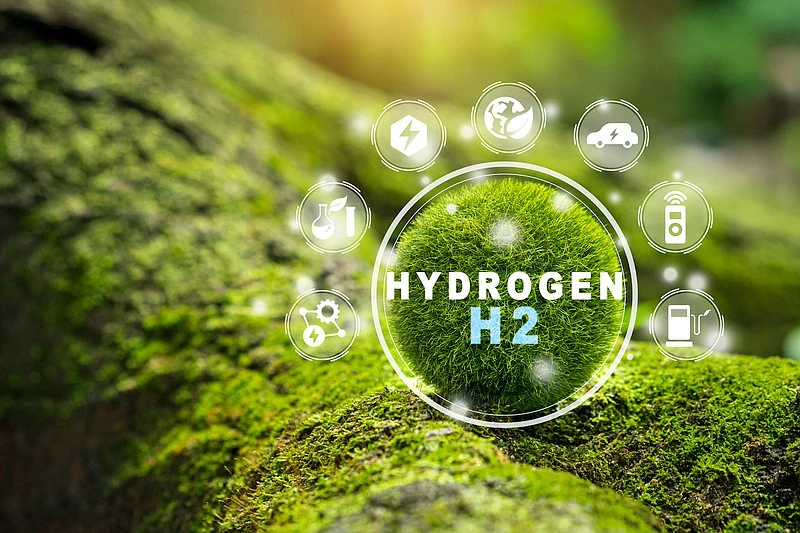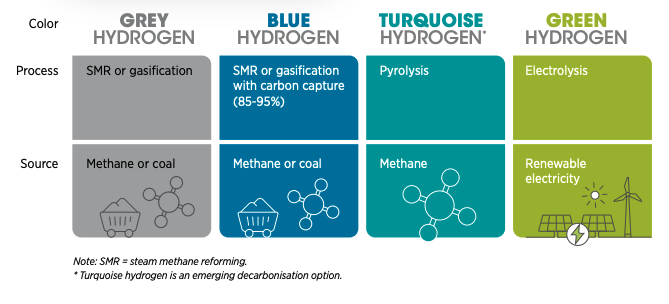That fuel is Hydrogen.
According to the International Energy Agency (IEA)'s latest Hydrogen Projects Dataset (HPD), the green hydrogen market - worth $676 million in 2022 - is predicted to 'explode' in 2027 when it reaches $7.3 billion, growing at a CAGR of 61.0% from 2022 to 2027.
Why is hydrogen the "boom" fuel of the future?
We have been using hydrogen since at least the 17th century, decades before anyone really knew what it was. The English naturalist Henry Cavendish (1731-1810) first recognized it as a separate element and named it in 1766.

According to the IEA, the green hydrogen market is expected to 'explode' by 2027, reaching 7.3 billion USD. Photo: Internet
Hydrogen is the most abundant element in the universe and is all around us, mostly in the form of water (H2O) and fossil fuels, also known as hydrocarbons. But it is very rare to find pure hydrogen in nature in gas form.
According to the IEA, hydrogen is a versatile energy carrier that can help address various key energy challenges. It will play a key role in the global energy transition.
With the development of science and technology, hydrogen is increasingly produced using processes that use solar energy, electrolysis or even biology.
There are many ways to use hydrogen: We use it to generate heat, create light, fertilize plants, and even for space travel.
In the chemical, refining, and metals industries, hydrogen serves as an energy carrier (e.g., to provide heat or electricity in metallurgy) or as a feedstock (e.g., for the production of ammonia).
According to economists , in the future, hydrogen could become an important source of renewable energy because it does not emit CO2 - when reacting with oxygen, hydrogen only produces electricity, water and heat;

Hydrogen is used in many different industries. Photo: Internet
At the same time, hydrogen plays an important role in replacing fossil fuels in industry. The IEA describes hydrogen as “a key pillar of industrial decarbonization.”
Green hydrogen alone was featured in a number of emissions reduction commitments at the United Nations Climate Conference, COP26, as a means to decarbonize heavy industry, long-haul transport, shipping and aviation.
China's ambitions in the green technology race
China sees hydrogen as a strategic “pioneering technology” in which it aims to become a global leader.
According to the Oxford Institute for Energy Studies (UK), China is the world's largest hydrogen producer with an annual output of 33 million tons, accounting for more than one-third of global demand.
The country is also the world's largest consumer of hydrogen. It is estimated that hydrogen will account for 10–12% of China's energy consumption by 2050, and up to 22% globally.
China is viewing hydrogen, especially green hydrogen (GH2), as a key element in its energy transition to achieve carbon neutrality and build a more sustainable economy.

The IEA describes hydrogen as "a key pillar of industrial decarbonisation". Photo: Internet
The reason is that China mainly produces brown and gray hydrogen using coal or gas (60% and 20% of production, respectively) with high CO2 emissions.
To reach the target of peaking carbon emissions by 2030 and then reaching carbon neutrality by 2060, green hydrogen – which currently accounts for about 1% of production – will need to replace grey hydrogen as quickly as possible, according to analysis by the Mercator Institute for China Studies.
The strategic role of green hydrogen has been emphasized in China's "Medium- and Long-Term Development Plan for Hydrogen Industry (2021–2035)".
Driven by China's carbon neutrality target, the chemical, steel and heavy transport industries will need large amounts of green hydrogen to realize the zero-carbon transition.
It is expected that by 2060, the country's annual hydrogen demand could increase to 100 million to 130 million tons, including 80 million to 100 million tons of green hydrogen, according to the RMI Institute (USA).
The report, “Unveiling China’s New Green Hydrogen Era,” details China’s roadmap to achieving its goal of producing 100,000 to 200,000 tons of green hydrogen annually by 2025.
According to RMI analysis, northwest China is expected to become the largest producer of green hydrogen due to abundant renewable energy resources and the need to decarbonize traditional coal-fired industries.
Inner Mongolia (northern China) has abundant solar and wind energy resources, making it an ideal place to produce green hydrogen. The province's production target for 2025 is 500,000 tons, much larger than the national target.
What colors of hydrogen are there?
According to the World Economic Forum (WEF), you may come across the terms “brown,” “grey,” “blue,” and “green” when describing hydrogen technology. It all depends on how it is produced.
Hydrogen only releases water when burned, but its production can be carbon-intensive. Depending on the method of production, hydrogen can be grey, brown, blue or green – and sometimes pink, yellow or turquoise.
However, green hydrogen is the only type produced in a climate-neutral way, making it crucial to reach net zero by 2050.

Depending on how it is produced, hydrogen can be grey, blue or green – and sometimes even pink, yellow or turquoise. Photo: International Renewable Energy Agency
Green hydrogen is defined as hydrogen produced by splitting water into hydrogen and oxygen using renewable electricity - said Dr. Emanuele Taibi, Head of Power Sector Transition Strategy, International Renewable Energy Agency (IRENA).
Traditionally, grey hydrogen is produced from methane (CH4), which is split with steam into CO2 – the main culprit in climate change – and H2, hydrogen.
Grey hydrogen is increasingly produced from coal, with significantly higher CO2 emissions per unit of hydrogen produced, so much so that it is often referred to as brown or black hydrogen rather than grey.
Blue hydrogen follows the same process as gray.
Source: WEF, IEA, Oxfordenergy, RMI, Mercator Institute for China Studies
Source




















































![[Maritime News] More than 80% of global container shipping capacity is in the hands of MSC and major shipping alliances](https://vphoto.vietnam.vn/thumb/402x226/vietnam/resource/IMAGE/2025/7/16/6b4d586c984b4cbf8c5680352b9eaeb0)













































Comment (0)